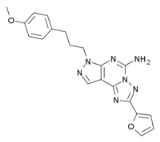
SCH-442,416
Encyclopedia
SCH-442,416 is a highly selective adenosine A2a
subtype receptor antagonist. It is widely used in its 11C radiolabelled form to map the distribution of A2a receptors in the brain, where they are mainly found in the striatum
, nucleus accumbens
, and olfactory tubercle
. Given its distribution in the brain, A2a receptors have been investigated for the treatment of various neurological disorders, and SCH-442,416 has shown promise in treatment of depression
, Parkinson's disease
, and catalepsy
.
Adenosine A2A receptor
The adenosine A2A receptor, also known as ADORA2A, is an adenosine receptor, but also denotes the human gene encoding it.-Structure:This protein is a member of the G protein-coupled receptor family which possess seven transmembrane alpha helices...
subtype receptor antagonist. It is widely used in its 11C radiolabelled form to map the distribution of A2a receptors in the brain, where they are mainly found in the striatum
Striatum
The striatum, also known as the neostriatum or striate nucleus, is a subcortical part of the forebrain. It is the major input station of the basal ganglia system. The striatum, in turn, gets input from the cerebral cortex...
, nucleus accumbens
Nucleus accumbens
The nucleus accumbens , also known as the accumbens nucleus or as the nucleus accumbens septi , is a collection of neurons and forms the main part of the ventral striatum...
, and olfactory tubercle
Olfactory tubercle
The olfactory tubercle is a structure involved in Olfaction.It is present in humans, but much smaller than it is in some other animals.It is a frequent subject of research.-External links:...
. Given its distribution in the brain, A2a receptors have been investigated for the treatment of various neurological disorders, and SCH-442,416 has shown promise in treatment of depression
Depression (mood)
Depression is a state of low mood and aversion to activity that can affect a person's thoughts, behaviour, feelings and physical well-being. Depressed people may feel sad, anxious, empty, hopeless, helpless, worthless, guilty, irritable, or restless...
, Parkinson's disease
Parkinson's disease
Parkinson's disease is a degenerative disorder of the central nervous system...
, and catalepsy
Catalepsy
Catalepsy is also a term used by hypnotists to refer to the state of making a hypnotised subject's arm, leg or back rigid. "Arm catalepsy" is often a pre-hypnotic test performed prior to an induction into a full trance.-Causes:...
.

